Minor 251 Progression Jazz Piano
After we have learnt the major 251 progression in all 12 keys it’s time to learn the minor 251 progression. Understand that minor harmony is much more complex than major harmony and it takes more time and patience to master.
How To Play A Minor 251 progression
We encounter a problem when we build the 2, 5 and 1 chords out of the natural minor scale. This is because the 5 chord in the natural minor scale is a minor 7th chord which creates a weak sense of resolution from the 5 chord to the 1 chord in the progression. We learnt in the lesson on the Major 251 Progression that the 5 chord must be a dominant 7 chord – this is where the Harmonic Minor Scale comes into play.
Before learning the minor 251, you should be familiar with the different types of minor scales and their uses and application in jazz piano.
The Harmonic Minor Scale
The harmonic minor scale is used to create more interesting harmonies in minor keys. To construct the harmonic minor scale, we take the natural minor scale and we raise the 7th note by half a step. So in the key of C we take the Bb and we raise it to B.

The harmonic minor scale has a middle-eastern quality at the top of the scale which gives it a very distinctive sound.
To build a minor 251 progression, the 5 chord comes from the harmonic minor scale of the key you are in. The 5 chord from the harmonic minor scale is always dominant in quality which creates a very strong sense of resolution to the 1 chord in the 251 progression.
What Changes in the Harmonic Minor Scale?
Now that we have raised the 7th note of the scale, we now have 4 different chords in the scale. We have already talked about the 5 chord so now let’s look at the other 3.
The 1 chord was a minor 7th chord in the natural minor scale, now that the minor 7th has been raised this creates a minor-major chord. You may not have come across minor major chords but as the name suggests they are a cross between minor and major chords and contain a minor 3rd and a major 7th.
The next chord that changes is the chord built of the 3rd degree. We did have an Eb major 7th chord in the natural minor scale, but now the 5th has been raised which creates an Eb augmented chord. An augment 7th chord is the same as a major 7th but the 5th has been raised by half a step.
Finally, the last chord that changes is the chord built off the 7th degree of the scale. In the natural minor scale this was a Bb7 chord but now that the 7th note of the scale has been raised we now have a B diminished chord.
Diminished chords create a greater sense of resolution from 7 to 1 in minor keys.
The II-7b5 Chord — The Minor 7b5 Chord
The 2 chord in a minor 251 progression is always a minor 7b5 chord. Minor 7 flat 5 chords are also known as half diminished chords and both terms refer to the same thing. This chord is built of the 2nd degree of the harmonic minor scale which makes it the 2 chord in a minor 251 progression.
The V7alt Chord — The Altered Dominant Chord
The 5 chord in a minor 251 progression is always an altered dominant chord. An altered dominant chord is a dominant chord where the upper extensions of the chord have been raised or lowered by half a step.
These alterations create extra dissonance and tension on the 5 chord and create a greater sense of resolution to the 1 chord in the progression.
The I-7 Chord — You Have 3 Options Here
Finally, we have the 1 chord. You have three options here.
The first is a normal minor 7th chord — the Bb isn’t actually in the key of C harmonic minor but you can still play that chord and it will still sound good.
The second option in a minor major chord — this is the diatonic 7th chord built of the 1st degree of C harmonic minor.
The third option is a minor 6th chord — here we have the root, 3rd, 5th and 6th — again, the A natural isn’t in the key of C Harmonic minor but you can use this chord.
Downloadable Lesson Supplement
Download the minor 251 progression notation for all 12 minor keys:
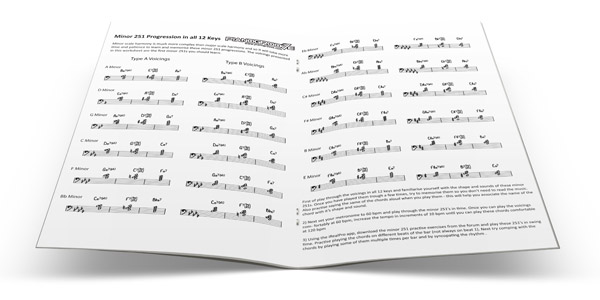 DOWNLOAD PDF
DOWNLOAD PDF
Lesson Downloads
Minor 251s In All 12 Keys
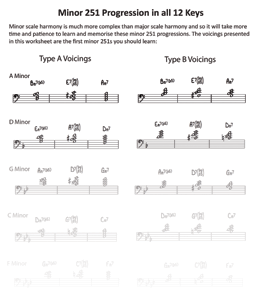
Minor 251s In All 12 Keys
Download a 2-page PDF of minor 251 progressions in all 12 keys. Great for drills and practice...
Practice Tips
-
The 5 chord in a minor 251 progression always comes from the harmonic minor scale
-
The trick with learning minor 251s is to visualize the starting position, if you can find that the rest of the progression will fall into place.
-
For the 2 chord we have a -7b5 chord, if we move it into the 1st or 3rd inversion - all we need to do is move the top or bottom 2 notes a half step in either direction and then you will be playing the V chord with a b9 and a #5 or b13.
-
This relationship works in any key, so if you know your -7b5 chord inversions, you have the formula to build every minor 251 progression.
-
Make sure that you are always analyzing and identifying the scale degrees that you are playing and you will gradually build a strong awareness of where these altered tones are located.
- The downloads will help you work out the notes but don’t become over reliant on the notation.


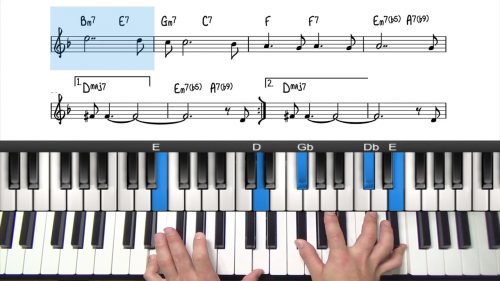
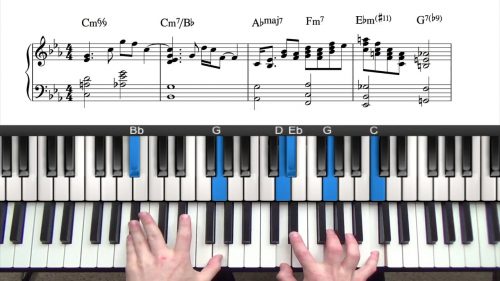
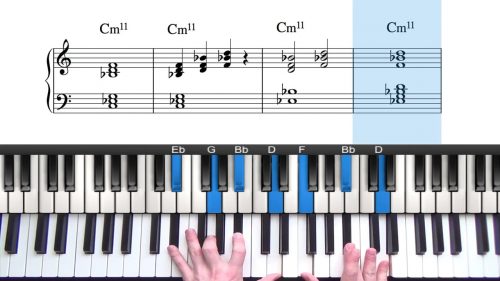


Hi Hayden, I found this lesson very useful. Are the chords that come from a harmonic minor scale played as modal scales — like the Ionian, Dorian, etc from a major scale ? I did try to play them as scales and they sounded quite exotic ! Cheers.
Hey Natasha, thanks for letting me know and I’m glad you found the lesson interesting :-)
Minor and major 251s are very important so try to get them under your fingers in all 12 keys. Perhaps focus on 3 or 4 keys at once, practice for a couple of weeks and then move onto the next 4 keys. This is better than trying to practice all 12 in one sitting.
To answer your question… Yes. In the same way that we derive modes from the Major Scale and the Melodic Minor Scale, we can derive 7 modes from the Harmonic Minor Scale. As you say, this mode has some very exotic sounds!
I would recommend first learning the major scale modes, and then melodic minor modes, these are by far the most useful and practical.
In the future we will certainly explore the modes of the Harmonic Minor and the application to jazz piano.
Hope this helps :-)
Hayden
I confess to being too cheap to pay for the lessons. But I’ve played classical piano for 45 years and for thirty-five years I have been banging my head against the wall trying to figure out jazz. I was able to get some basic concepts but the rest has been like black magic. I’ve gotten many books, but all those wacky chords were like learning a new language by memorizing piles of vocabulary without knowing the meanings of the words or having any grammar to string them together. Your video on chord extensions changed my life — a light bulb suddenly went off, or I suddenly got a key that unlocked all the magic. I watched a couple of your other videos, and then had another revelatory experience with the major 2-5-1 video. I’ve been able to make sense now out of what the books were trying to teach me, and in four months I’ve made more progress than in the previous 35 years. I’ve watched many of your other videos (including the minor 2-5-1) and am immensely grateful. I’ve referred some gifted secondary school pianists to your site as well and they are very excited. Thank you, thank you, thank you!
Patrick Nugent
Executive Director
The Annapolis Symphony Orchestra
Annapolis, Maryland, USA
Hey Patrick, I’m really happy to hear about your progress :-)
251s are the DNA of jazz and so spend time to learn these important progressions in all 12 keys. These progressions occur in pretty much every jazz standard you will come across and so spending the time to learn them properly will help you down the line.
Also remember to download the lesson supplements to help you learn and memorise these important progressions – but don’t become reliant on the notation! You need to be able to ‘see’ the chord tones, extensions and alterations on the keyboard.
And thanks for the recommendations to your students… much appreciated.
If I can help you with anything you are working on, just let me know.
Cheers,
Hayden
Hey Hayden,
Thanks for another excellent lesson. Do you have any tips for distinguishing b9b13 chords from half-diminished chords? For example, when I play the G7(b9b13), I see it as F half-diminished because they have the same notes. When you think to yourself, “I’m gonna play a G7(b9b13),” do you think of it as just an F half diminished? Or are you able to quickly parse it out as the 7, b9, 3, and b13 of G? If so, how do you recommend practicing that?
I hope that made sense. Thanks!
Hi Deven 👋
Good question!
As you learn more voicings, you will find much overlap. For example:
If you take those notes F – A# – B – & Eb
– This could be a rootless voicing for Db13 – from bottom to top we have 3, 13, b7 & 9
– It could also be a rootless G7#5#9 (as you point out) – from bottom to top we have b7, #9, 3 & #5 (think tritone sub Db7/G7)
– It could also be a F-11b5 – from bottom to top we have R, 11, b5 & b7
They are the more obvious ones, but it could also be many other things.
Play that voicings in your right hand (Gb – Bb – C & F) and then play the bass notes: Ab, D and C underneath… see how the chord completely changes it’s flavour simply by changing the bass note.
This then leads onto the very important point of ‘intent’ …
If I see a Cmaj7, I could play just B (7), C (R) & D (9). This is a cluster voicing. From a classical standpoint, this voicing does not follow the rules of traditional harmony. There is no 3rd in the chord which from a classical standpoint makes no sense, but in jazz, if you play this in your left hand for Cmaj7, it can sound very interesting. I wouldn’t use this voicing all the time for Cmaj7 but it can be nice to throw in a more ‘obscure’ voicing like from time to time.
Those same 3 notes could also imply A-11, F#-7b5, D-, Fmaj7#11… the root is missing from each of those chords but regardless it can still function as that chord.
It’s all down to your intent which in many ways gives you a lot of freedom with the voicings you play.
This is a hard area to grasp for some students because in classical/traditional harmony we are conditioned into analysing and naming chords in their root position.
Whereas in jazz this isn’t the case, there are lots and lots of ways to voice a chord and 1 voicing can actually function as many different chords as in the example highlighted above. Complicated and confusing i know but also very liberating at the same time!
Hope this helps Deven, if you’d like me to elaborate on anything here just let me know.
Cheers,
Hayden
Hey Hayden,
Thanks for another excellent lesson. Do you have any tips for distinguishing b9b13 chords from half-diminished chords? For example, when I play the G7(b9b13), I see it as F half-diminished because they have the same notes. When you think to yourself, “I’m gonna play a G7(b9b13),” do you think of it as just an F half diminished? Or are you able to quickly parse it out as the 7, b9, 3, and b13 of G? If so, how do you recommend practicing that?
I hope that made sense. Thanks!
Hi Deven,
Good question!
As you learn more voicings, you will find much overlap. For example if you take those notes F – A# – B – & Eb
– This could be a rootless voicing for Db13 – from bottom to top we have 3, 13, b7 & 9
– It could also be a rootless G7#5#9 (as you point out) – from bottom to top we have b7, #9, 3 & #5 (think tritone sub Db7/G7)
– It could also be a F-11b5 – from bottom to top we have R, 11, b5 & b7
They are the more obvious ones, but it could also be many other things.
Play that voicings in your right hand (F – A# – B – & Eb) and then play the bass notes: G, Db and F underneath… see how the chord completely changes it’s flavour simply by changing the bass note in your left hand.
This then leads onto the very important point of ‘intent’ …
If I see a Cmaj7, I could play just B (7), C (R) & D (9). This is a cluster voicing: pianogroove.com/jazz-piano-lessons/cluster-voicings/ – This voicing does not follow the rules of traditional harmony. There is no 3rd in the chord which from a classical standpoint makes no sense, but in jazz, if you play this in your left hand for Cmaj7, it can sound very interesting. I wouldn’t use this voicing all the time for Cmaj7 but it can be nice to throw in a more ‘obscure’ voicing like from time to time.
Those same 3 notes could also imply A-11, F#-7b5, D-7, Fmaj7#11… the root is missing from each of those chords but regardless it can still function as that chord.
It’s all down to your intent which in many ways gives you a lot of freedom with the voicings you play. This is a hard area to grasp for some students because in classical/traditional harmony we are conditioned into analysing and naming chords in their root position.
Whereas in jazz this isn’t the case, there are lots of ways to voice a chord and 1 voicing can actually function as many different chords as in the example highlighted above. Complicated and confusing i know but also very liberating at the same time!
Hope this helps Deven, if you’d like me to elaborate on anything here just let me know.
Cheers,
Hayden
So, why a root but no 9 in the minor chord? Is it just because of voice leading to the dominant chord?
Hi Dave,
Yes that’s right. Playing the root in the II-7b5 chord creates very smooth voice leading to the V7alt chord.
Once you play the II-7b5 chord in the 1st or 3rd inversion, the rest of the progression should just fall into place under your fingers with very little movement in the hand.
Hope this helps :-)
Hayden
Although I am progressing with practice and understanding of the Minor 251 it can be confusing. I was relieved to read your comment below about learning the patterns well in a few keys and then keep adding keys, which I do, but for all 12 keys, initially, too overwhelming and feel I cannot keep up. But then reading the comments between you and Devon confusion seeped in,, So the b13th is the same as the #5th.. correct??? I prefer to notate it as a #, ie. GV #5, B9 as D# to keep clear,, and all of these in the base of Cminor as the 1 chord. But where did the F A# B Eb come from???, although I get the concept and see the overlap,, it is so incredibly interrelated and beautiful. Still confused about rootless voicings and see how they are essential to the Major 251 but only used in Minor 251 on the one chord. Is that correct.??? Is voicing a more general term?? And rootless, Bill Evansy, or…… I do understand the sound and the access to smooth transition.
One other bit that threw me initially on the V chord of the Major 251,, we are substituting the 13th for the 5th, (replacing the 5th with the 13th}, correct.??? And what is a b7???? Flat from what?? Minor 7 and dom 7 are the same (the 3rd differs}, correct.??
Geez, i had a lot of queries…but my analytical mind gets stuck,, so thank you. I get so much out of your lessons even tho I have to review a lot after practicing a while,, but that is how learning goes…. practice, repeat, relearn again with more solid grasp.
I think you are great and we are all progressing. thank you
PS.. I got the Bossa Nova down finally,, reviewed the lesson,, listened to you play it,, it is such fun and great to practice in all keys now…. well not all the minor 251s yet….
Hi Cheryl 👋
Yes learn them in sets of 3 or 4 keys at a time. Perhaps spend a week or 2 on each set, and then move onto the next set. It’s important to practice them, and then revisit them a couple days later. Then repeat.
The next and very important stage Cheryl, is to practice them in context of jazz standards, the following lessons are great for applying/practicing minor harmony and minor 251s:
Beautiful Love: pianogroove.com/jazz-piano-lessons/beautiful-love-tutorial/
Stella By Starlight: pianogroove.com/jazz-piano-lessons/stella-starlight-tutorial/
Alone Together: pianogroove.com/jazz-piano-lessons/alone-together-left-hand-voicings/
The Shadow Of Your Smile: pianogroove.com/jazz-piano-lessons/the-shadow-of-your-smile-tutorial/
You Don’t Know What Love Is: pianogroove.com/jazz-piano-lessons/you-dont-know-what-love-is-tutorial/
Those 5 tunes contain lots of minor harmony. When you play the progressions in context of tunes, you will retain the information much better than by simply drilling through the progressions. But you must start by drilling them just to get familiar with them.
An important point Cheryl:
Whenever you come across a minor 251 in a jazz standard, stop and play it in Type A, then Type B, and then play through the measure with both of those variations with the melody on top.
Sometimes you might get it straight away, if it’s a 251 in D Minor for example – a straight-forward and common key.
But if it’s a 251 in C# Minor, or F# Minor, it will probably take you longer to figure out. Spend the time to figure it out, both Type A and Type B.
The point is, if you come across a 251 in a jazz standard that you are not familiar with, then isolate it and drill it until you are comfortable with it. Then play it in context of the standard with the melody over the top. That is the formula for remembering the voicings. This doesn’t happen overnight… it will happen gradually. Minor 251s are tricky to learn so don’t be disheartened by slow progress!
Yes the #5 and the b13 are enharmonic, ie. they are the same note. As if jazz is not hard enough, there is no set way that musicians refer to alterations. I prefer the #5, but I mention both in different lessons to make students aware of this.
Yes in minor 251s, it’s nice to include the root in the II-7b5 chord, the is because it voice-leads beautifully up a half step to the #5/b13 (remember in minor 251s, the V7 chord is an altered dominant chord and so that #5/b13 alteration sounds great).
Finally, all dominant chords have a b7. For it to be a dominant chord, it must have a b7, and so it isn’t flat from anything, the b7 must be there for it to be a dominant chord. … Don’t confuse your essential chord tones with the alterations Cheryl! Yes for dominant chords you have major3 and b7, minor chords both b3 and b7 – always. in every key.
Awesome, great news with the bossa, taking these progressions and playing them with a different feel, such as a bossa feel, will further cement the shapes and sounds in your brain.
Cheers,
Hayden
Hi, I’m a bit confused. So I’m playing by ear and trying to figure out progressions that sound good to me but I get confused with rootless left hand voicings on where to go next. For example, in the key of E major, I stumbled upon a melody that sounds nice to me, still working on it but it starts from Emaj7 to Amaj7 then Abmaj7. When I use the root voicings i.e. starting from root position Emaj7 then going to tight Amaj7 back and forth, it sounds alright, I can typically get around. However when I switch to using rootless voicings i.e., playing the Emaj7 with a Ab at the root, and the dropping down to the rootless Amaj7, it still sounds good but the melody doesn’t fit as well.
My question is, when I play the root voicings, am I playing in Db minor instead of Emaj? I get confused on how to move around. For example, with the rootless voicings I somehow end up doing a 2-5-1 minor progression ending with a rootless Db minor chord (Emaj7 root). I don’t know which scale I’m in. Does it even matter? Sorry if it’s confusing.
Hi Tobi,
Rootless voicings are often difficult to grasp, particularly with student coming from classical piano studies.
I have written up an in-depth form post on rootless voicings here: pianogroove.com/community/t/understanding-rootless-voicings/945
The short answer to your question, is that the chord doesn’t change when you leave out the root. It’s simply a different way of voicing the chord.
Read over the post above, and if you have further questions let me know and I’m more to happy to elaborate on anything you are unsure on.
Cheers,
Hayden
Hey Hayden,
So for the diatonic harmonic minor scale for C, it is:
– CmMaj7 – D7b5 – EbMaj7(#5) – Fm7 -> G7 -> AbMaj7 -> Bdim7
Can you generalize and play this for all keys?
– mMaj7 – 7b5 – Maj7#5 – m7 – 7 – Maj7 – dim7
For instance, a diatonic harmonic minor scale for F would be:
– FmMaj7 – G7b5 – AbMaj7#5 – Bbm7 – C7 – DMaj7 – Edim7
Thanks!
– Sean
Hi Dokko,
Yes that’s exactly right… it’s a great idea to learn and memorise the diatonic 7th chord formulas for the major scale, the melodic minor scale, and the harmonic minor scale.
This formula is instantly transferable and gives you the ‘blue-print’ to find the diatonic 7th chords in any key.
One thing I noticed with your conversion to F Harmonic Minor, the diatonic 7th chord built off 6th degree would be Dbmaj7, not Dmaj7.
I always find it useful to memorise the relation to the major scale, ie. the harmonic minor scale is the major scale with b3 and b6. So F Harmonic Minor Scale would contain the b6 which is Db – making that diatonic 7th chord Dbmaj7.
Hope this helps and if you’d like me to elaborate on anything, just let me know.
Cheers,
Hayden
Hey Hayden,
I’m wondering why in the minor 2-5-1s, in the II-7b5 chords, why we include the root in “rootless” voicings. For Dm7b5, Type A is F-Ab-C-D. I’ve been practicing them this way and plan to work on the more advanced minor 2-5-1 lessons next.
But I’m wondering if it’s worthwhile to practice them with the 9th as in the Major 2-5-1s. Like for Dm7b5, using a F-Ab-C-E voicing, then moving the top two notes down a half-step going to F-Ab-B-Eb for G7b9#5. I didn’t see this mentioned in the advanced minor 2-5-1 rootless voicing PDF lesson either.
Is there a reason that this isn’t characteristic for these types of minor 2-5-1 voicings, or should I practice them too? Just wondering what the theoretical/practical rational for using inversions here instead of 9th voicings on the first chord.
Thanks for the insight!
Hi Hayden,
In the lesson you explained ll start from first inversion and third inversion. Do I need to practice from second inversion or I can just skip it? (same question for the major 251 practice, which have more possibilites because of the 9th)
Thanks,
Yufei